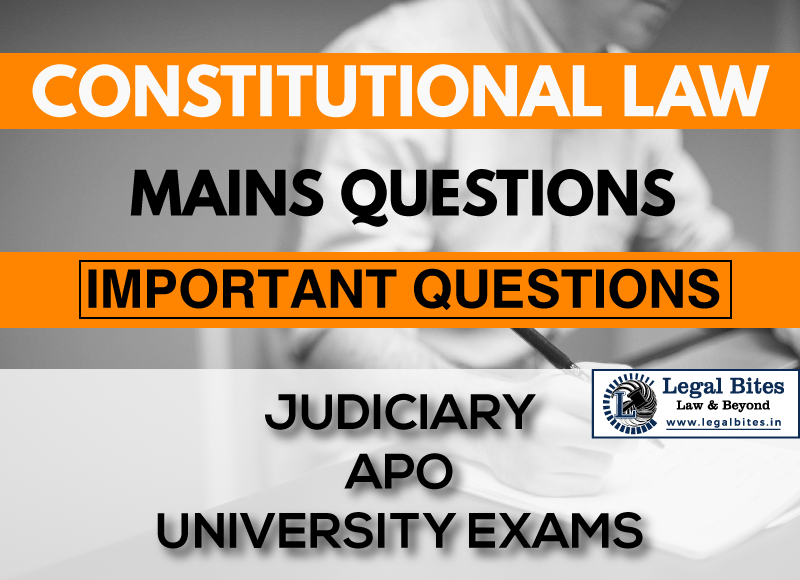Describe the procedure of amendment of Constitution of India. Under what circumstances the amendment requires to be ratified by the legislatures of the States?
Question: Describe the procedure of amendment of the Constitution of India. Under what circumstances the amendment requires to be ratified by the legislatures of the States? [MPJS 2012] Find the answer to the mains question only on Legal Bites. [Describe the procedure of amendment of Constitution of India. Under what circumstances the amendment requires to be ratified by… Read More »

Question: Describe the procedure of amendment of the Constitution of India. Under what circumstances the amendment requires to be ratified by the legislatures of the States? [MPJS 2012] Find the answer to the mains question only on Legal Bites. [Describe the procedure of amendment of Constitution of India. Under what circumstances the amendment requires to be ratified by the legislatures of the States?] Answer The Constitution of India provides for its amendment in order to adjust itself to...
Question: Describe the procedure of amendment of the Constitution of India. Under what circumstances the amendment requires to be ratified by the legislatures of the States? [MPJS 2012]
Find the answer to the mains question only on Legal Bites. [Describe the procedure of amendment of Constitution of India. Under what circumstances the amendment requires to be ratified by the legislatures of the States?]
Answer
The Constitution of India provides for its amendment in order to adjust itself to the changing conditions and needs. Article 368 in Part XX of the Constitution deals with the powers of Parliament to amend the Constitution and its procedure.
The procedure for the amendment of the Constitution as laid down under Article 368 is as follows:
- An amendment of the Constitution can be initiated only by the introduction of a bill for the purpose in either House of Parliament and not in the state legislatures.
- The bill can be introduced either by a minister or by a private member and does not require prior permission from the president.
- The bill must be passed in each House by a special majority, that is, a majority of the total membership of the House and a majority of two-thirds of the members of the House present and voting.
- Each House must pass the bill separately. In case of a disagreement between the two Houses, there is no provision for holding a joint sitting of the two Houses for the purpose of deliberation and passage of the bill.
- If the bill seeks to amend the federal provisions of the Constitution, it must also be ratified by the legislatures of half of the states by a simple majority.
- After duly passed by both the Houses of Parliament and ratified by the state legislatures, where necessary, the bill is presented to the President for assent.
- The President must give his assent to the bill. He can neither withhold his assent to the bill nor return the bill to the Parliament for reconsideration.
- After the President’s assent, the bill becomes an Act (i.e., a Constitutional Amendment Act) and the Constitution stands amended in accordance with the terms of the Act.
The role of the states in the constitutional amendment is limited. State legislatures cannot initiate any Bill or proposal for amendment of the Constitution. They are associated in the process of the amendment only through the ratification procedure laid down in Article 368, in case the amendment seeks to make any change in any of the provisions mentioned in the proviso to Article 368.
The only other provision for constitutional changes by state legislatures is to initiate the process for creating or abolishing Legislative Councils in their respective legislatures and to give their views on a proposed Parliamentary bill seeking to affect the area, boundaries, or name of any State or States which has been referred to them under the proviso to Article 3 such as GST bill, reservation.
In Kihota Hollohon v. Zachilhu (AIR 1993 SC 412) case in which the constitutional validity of the Tenth Schedule of the Constitution inserted by the 52nd Amendment in 1985 was challenged. The decisions of the Speakers/Chairmen on disqualification, which had been challenged in different High Courts through different petitions, were heard by a five-member Constitution Bench of the Supreme Court.
The Constitution Bench in its majority judgment upheld the validity of the Tenth Schedule but declared Paragraph 7 of the Schedule invalid because it was not ratified by the required number of the Legislatures of the States as it brought about in terms and effect, a change in Articles 136, 226 and 227 of the Constitution.
Important Mains Questions Series for Judiciary, APO & University Exams
- Constitutional Law Mains Questions Series Part-I
- Constitutional Law Mains Questions Series Part-I
- Constitutional Law Mains Questions Series Part-II
- Constitutional Law Mains Questions Series Part-IV
- Constitutional Law Mains Questions Series Part-V
- Constitutional Law Mains Questions Series Part-VI
- Constitutional Law Mains Questions Series Part-VII
- Constitutional Law Mains Questions Series Part-VIII
- Constitutional Law Mains Questions Series Part-IX
- Constitutional Law Mains Questions Series Part-X
Admin Legal Bites
Legal Bites Study Materials correspond to what is taught in law schools and what is tested in competitive exams. It pledges to offer a competitive advantage, prepare for tests, and save a lot of money.

